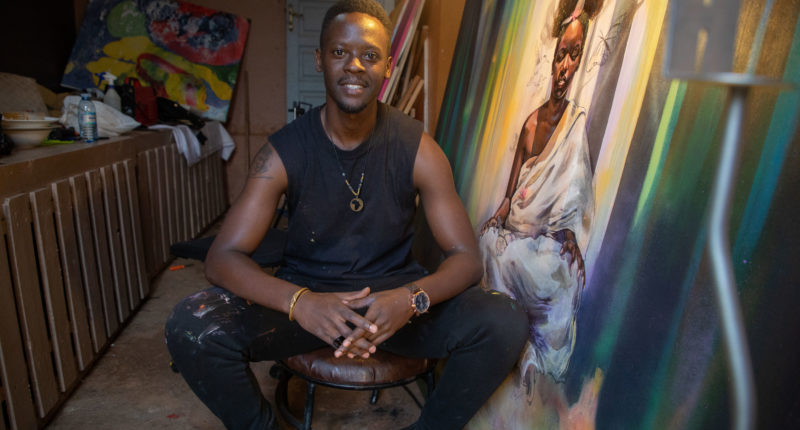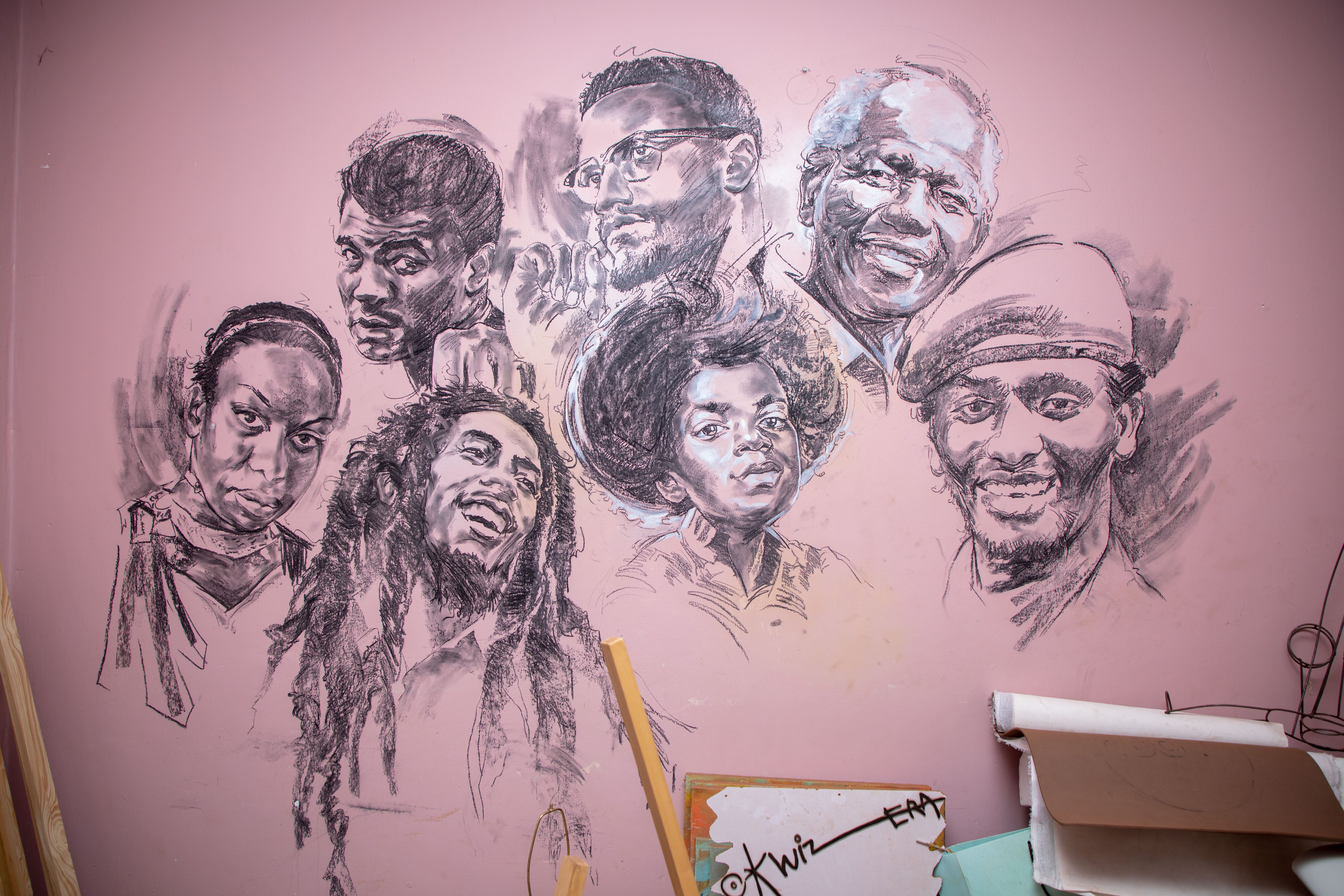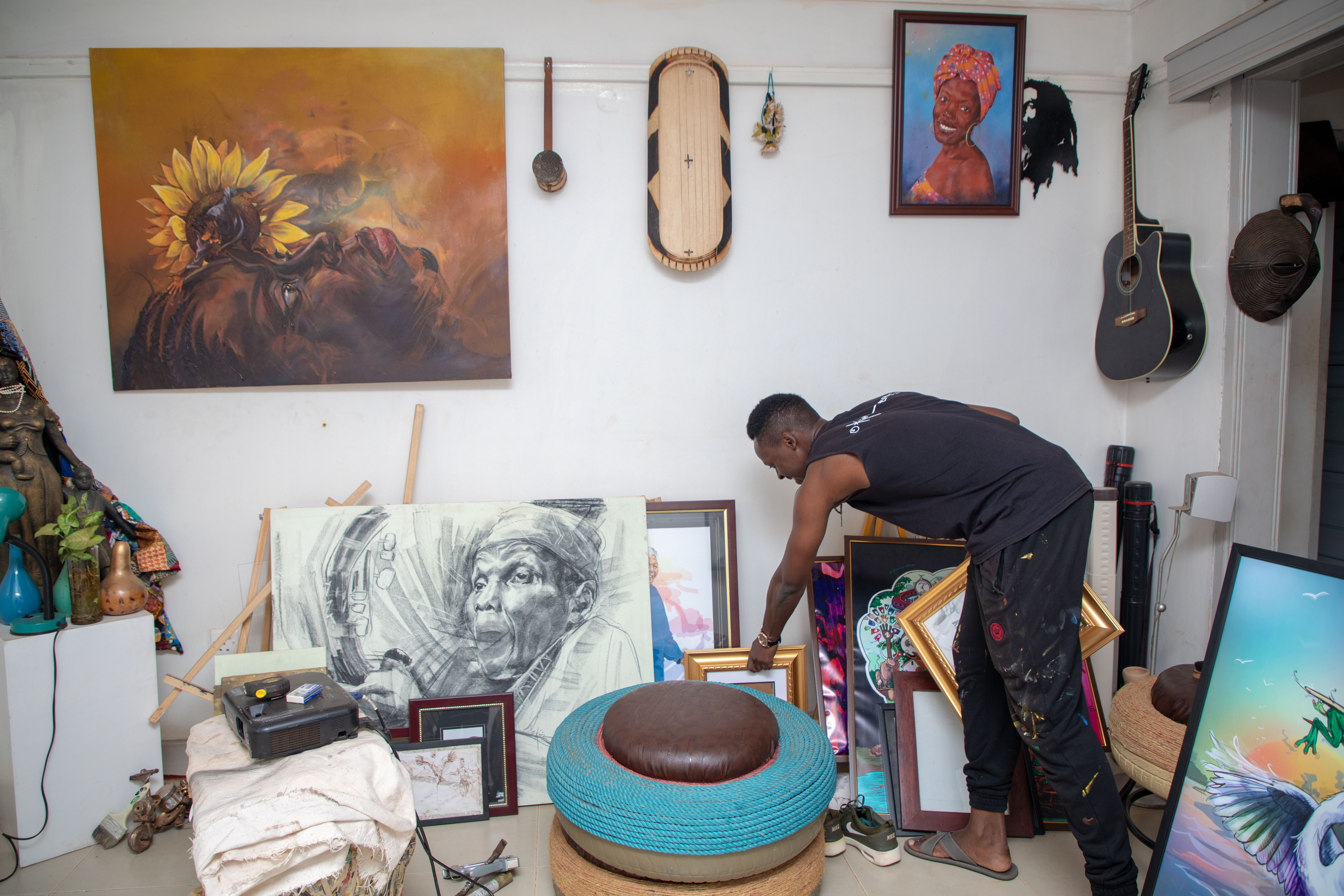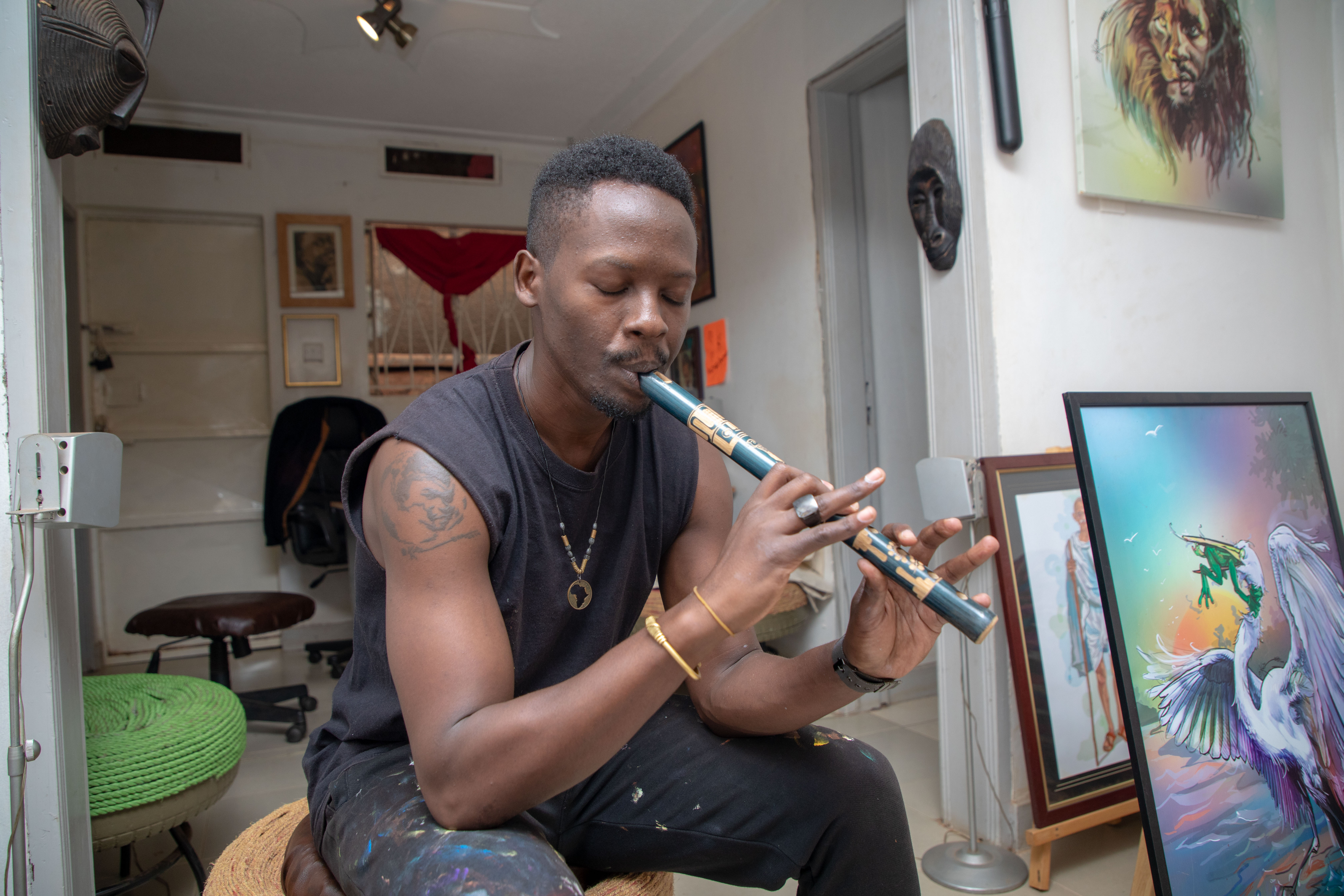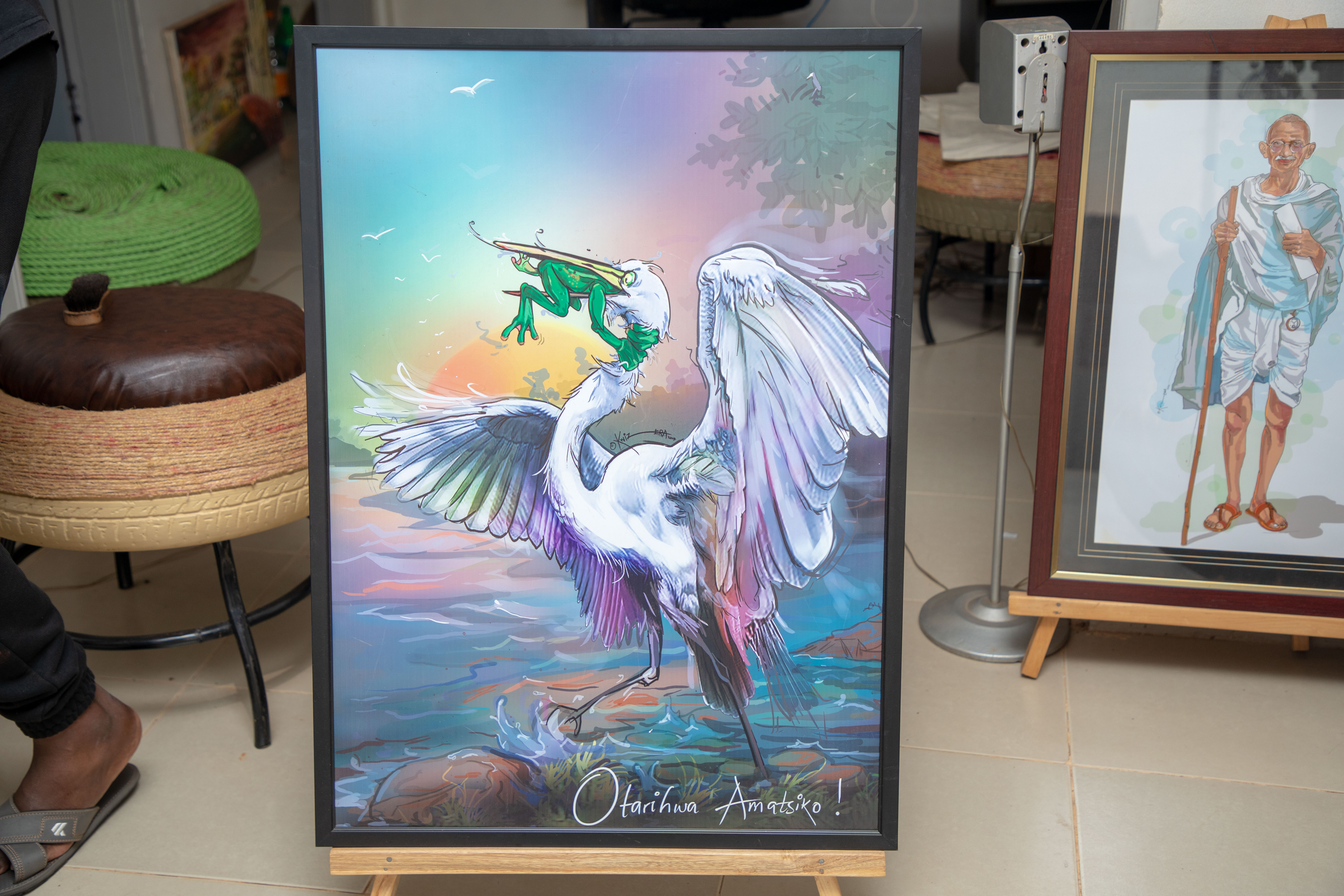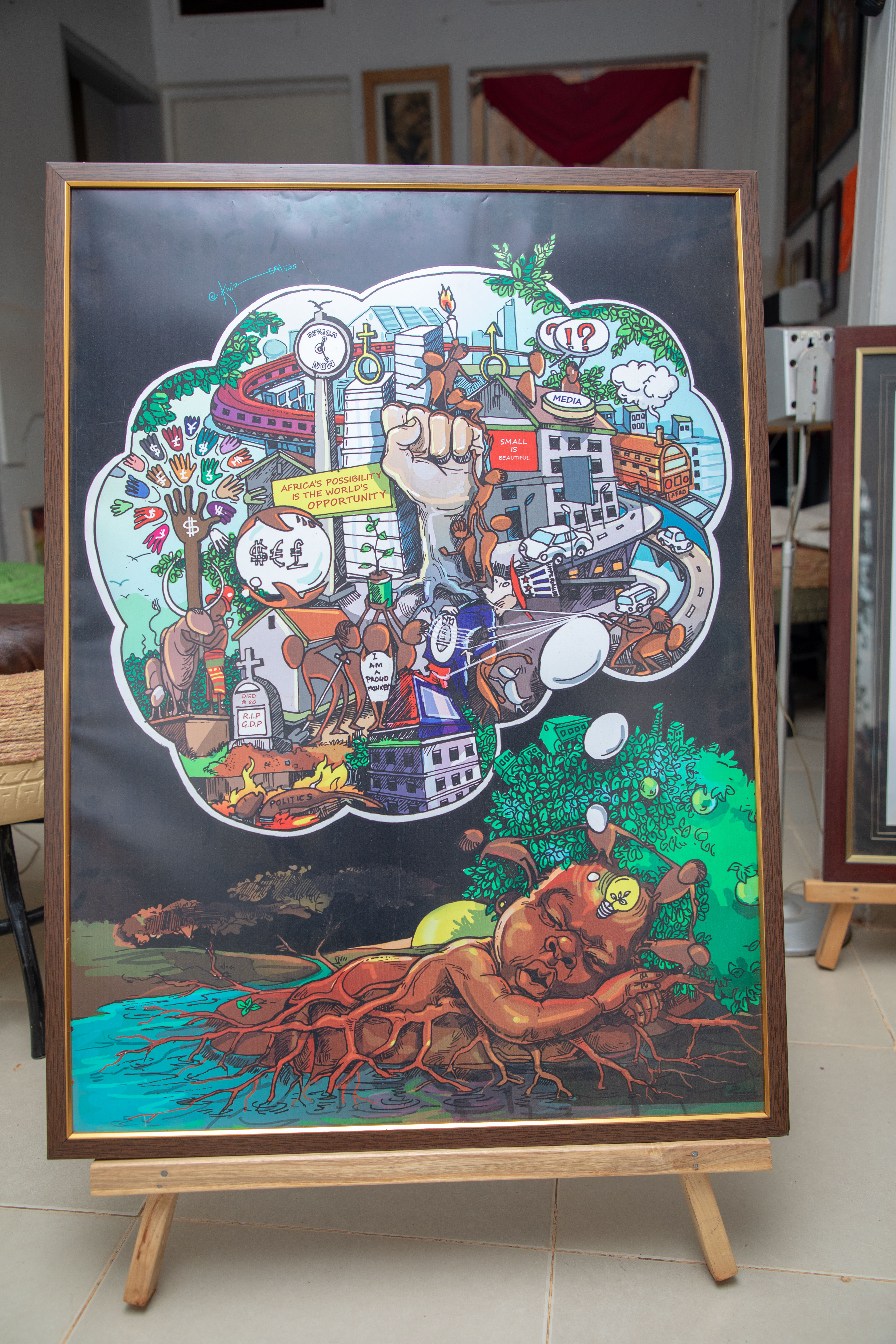They say to each their own. To an artist nothing is more glorious than their thinking space. A space where they can drown their imagination wandering off without boundaries of movement but only thought. Ugandan artist Alex Kwizera shared with me the power behind this creative process.
Kwizera’s is a house full of brushes, paint and paintings. As you enter the gate, you cannot fail but notice the different pieces of art littered in the compound. From the empty wine bottles in different shades of green lining up the front veranda to the abandoned installations of incomplete sculptures whose shape my mind could not figure out, to the hanging flower pots surging all over the walls; you can clearly tell, this is an artist’s space.
On entering through the front door, I am greeted with a sensational smell of new paint hovering over the white draped room. A stash of complete paintings and illustrations are assembled on the floor covering the left hand side of the-would-be sitting room.
A brown canvas with a face of a woman hangs in the middle of the wall. “I’m still painting that one,” my host says pointing at the brown canvas, “It’s going to be part of my exhibition later on in the year.”
Before I can fully immerse myself in it, he calls me outside, “There is this one too,” pointing at another painting on the right hand side. I turn to follow him towards his work table only to find a portrait of Rastafarian Chronixx, his face, half lion, half human staring at me. I ignore the urge to draw closer to it. I fear to touch these paintings. They look so clean and natural. They look alive, so I avoid harming them. My hands are dirty, I remind myself.
Kwizera ushers me into his home office. A brown table at the centre of the room stands between a big rolling black leather covered chair and the wall. This, in the traditional house setting, should have been the dining room.
He offers me a seat. It is a raised three stand stool with a cushion filling the wide gap of the car tyre encircled with a sisal rope design. He does not seat on the big chair, he joins me on another similar stool astride mine and we begin our conversation.
Alex is a tall man who strikes you by a rather very deep voice. First, he tells me about his name and how he has built the brand Kwiz Era. It looks like they are two names in one. “It took me some time to come up with my name. It is more of a trademark to me than a logo,” he pauses with a brief laughter, “I introduce myself as ‘Kwiz’ that’s my name followed with a long dash, then ‘Era’.”
“It is an era. My time. As Kwiz, I live in this Era. The dash is to show the scope of time in which I live. It’s the symbol of my relevance.”
I later had a sit-down to talk more about his art and the growing influence of artists like him on the Ugandan arts scene.
David Kangye (DK): Have you ever done anything else other than art?
Alex Kwizera (AK): No. it has always been art, for me. Professionally, I have been pursuing art for the last eight years. From the time I was a child, I pursued art. I was that kid that dismantled and assembled everything I lay my hands on. I would draw pictures of my friends on paper, tear up leaves into shapes and of course, it always earned me a different currency! (He shies away looking on the ground)
DK: Which one?
AK: I was beaten. My parents couldn’t understand what I was doing. My books always ran out of pages earlier than others’. Then the teachers too became inquisitive only to realise, half the book had class notes and the other had drawings of the film stars of the time; Rambo, Schwarzenegger and Jackie Chan. More sticks!
DK: And you still didn’t give up?
AK: I couldn’t. It wasn’t me. It’s all I could ever find myself doing. A time came and my mother got tired of the clay sculptures I was hanging in her neatly organised house. She gave me a cabinet to keep them. That was acceptance.
Even at school, teachers got tired of beating me and instead started giving me gigs to draw their charts to be used in classrooms at a fee. It wasn’t much but it met my needs at break time. When my father saw the seriousness with which the teachers treasured my art, he kind of relented.
Upon joining secondary [school], I began experimenting different forms of art and this made me love art the more.
DK: What kind of art do you do today?
AK: I do portraits, illustration and live event painting. I paint on canvas and on the screen. I have done a number of illustration projects. Illustration helped me while I was at university to be able to meet my bills. I once asked my father to give me money to buy a canvas, and he thought I needed a new pair of canvas shoes. That’s when it crossed my mind that I needed to avail some of these items to myself.
DK: Wasn’t that reason enough to discourage you?
AK: On the contrary, it encouraged me. My parents became supportive generally. For example, they allowed me to study art all through school till university unbothered. They didn’t know much about the subject but nonetheless they were supportive.
DK: How has society shaped your art?
AK: Art is subjective. It can be heaven to one and hell to another. As an artist, you do the painting for yourself first even if it’s a commissioned piece. Society will always embrace art consciously or subconsciously. Art has generally many angles. There are those that claim to understand it but don’t. Others have no idea at all about the piece but they still buy it because the art piece can easily blend with the wall colours back home or at their office.
Art reveals our everyday situations told in multiple dimensions. That’s why artists can easily “talk” about a political subject and get away with it.
Art has taught me to appreciate people. I used to get offended with people who didn’t understand my work but I have learnt to look at things differently. We are different and see the same thing differently.
Today, art is a tool of social justice and we can no longer hide as artists. We have too much power. And the power of art is an element in a revolution.
DK: Don’t you feel intimidated when art is used to address hot political topics?
AK: Art has a way of touching delicate topics with subtlety. Usually this is done through sarcastic humour. Humour has a way of emphasizing something in a very unusual way. However, as an artist, you ought to be aware that your work could be used to make or break you. All art is a form of creation. It is a channel through which you let out your emotion. What the consumer takes away is none of your business.
Each and every piece of art has three forms of interpretation:
- The message the creator intends to make
- The message the art piece communicates
- The message interpreted by the audience
DK: Where do you see yourself as an artist in the next decade?
AK: I would like to have a bigger studio where I can have passionate young artists come and train to better their skills. They shouldn’t be going through what we did. There’s a lot of stigma against artists out there. No one else should go through what I did. Artists need a therapeutic place where they can freely exercise their artistry. The process of creation comes from a place of ultimate love, a place where time becomes still, a place where one can transcend beyond the circumstances of life. Such a place has no limits. Yet there are not many of such places around us.
DK: How have you found art as a business?
AK: There is a very wide market for art. It is as wide as it can be. It comes in different shades. Art is a culture everyone individually identifies with. With social media today, the place of the middleman is slowly fading out. Online galleries are performing better than big showrooms reaching more people than the gallery could ever open its doors to.
More people are yet to appreciate art but nonetheless we are getting there. When my father visits my studio, he wonders how people can spend money on a painting! We might still be shy understanding and appreciating the power and value of art but we shall get there.
DK: Would you rather do something else other than art?
AK: I also get shocked when I finish a painting. I get shocked at what I deliver. I am so immersed in art that every day is a new day and that is something I want to do forever. Art has something spiritual about it. It is a God’s given right to be a co-creator. Knowing that I have this power to co-create humbles me. You cannot explain this power within you to someone who has not experienced it before. I have been consumed by art and it is such a sacred thing to me.
